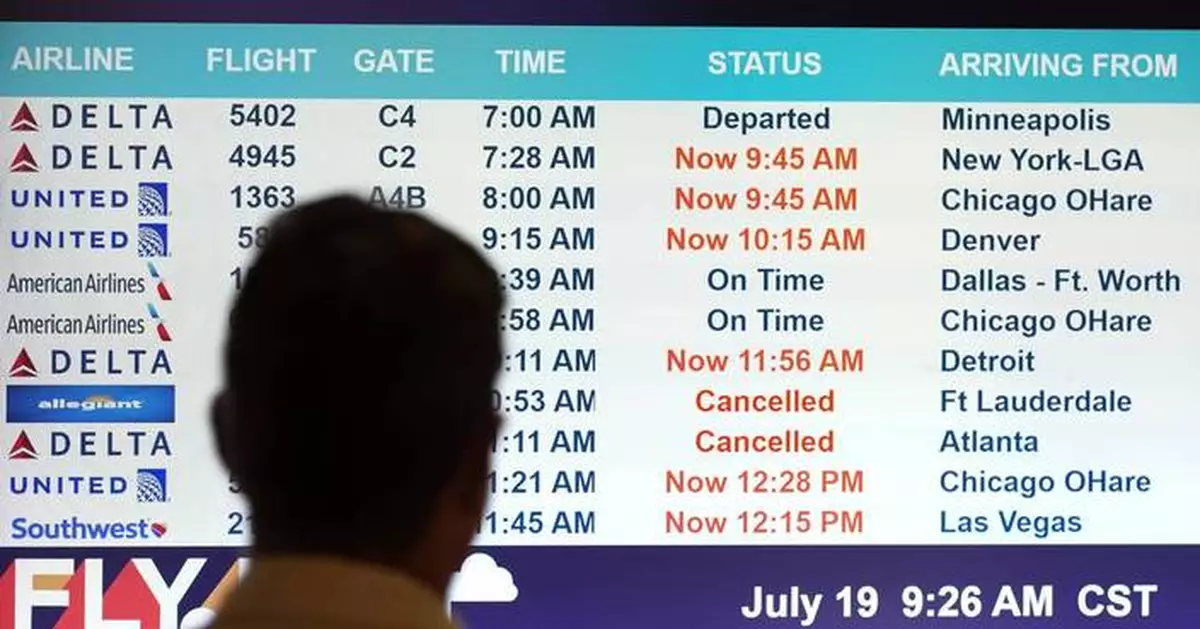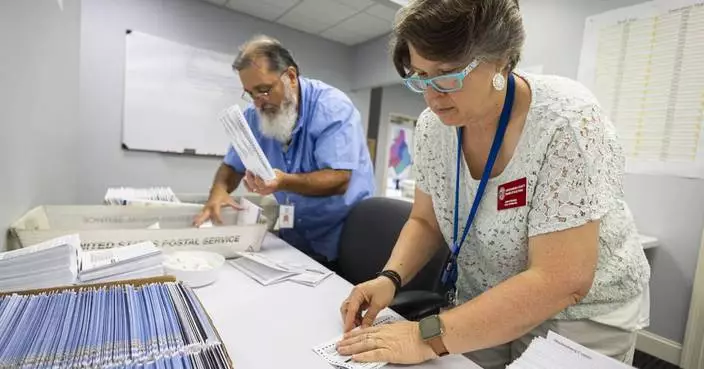NEW YORK (AP) — Much of the world faced online disarray Friday as a widespread technology outage affected companies and services across industries — grounding flights, knocking banks and hospital systems offline and media outlets off air.
At the heart of the massive disruption is CrowdStrike, a cybersecurity firm that provides software to scores of companies worldwide. The company says the problem occurred when it deployed a faulty update to computers running Microsoft Windows, noting that the issue behind the outage was not a security incident or cyberattack.
CrowdStrike has said a fix is on the way. Still, chaos deepened hours after the problem was first detected.
Here's what you need to know.
Friday's disruptions began when a faulty update was pushed out from CrowdStrike for one of its tools, “Falcon.” In a statement about the ongoing situation, the company said the defect was found “in a single content update for Windows hosts” — noting that Mac and Linux systems were not impacted.
But, because scores of companies rely on CrowdStrike for their security needs with Windows as their operating system, the consequences of this kind of technical problem have been far-reaching. As a result, affected computer after computer showed the “blue screen of death" error message.
Long lines formed at airports in the U.S., Europe and Asia as airlines lost access to check-in and booking services during peak summer travel — disrupting thousands of flights. Banks in South Africa and New Zealand reported outages impacting payments. Some news stations, particuarly in Australia, were unable to broadcast for hours. And hospitals had problems with their appointment systems, leading to delays and sometimes cancelations for critical care, while officials in some U.S. states warned of 911 problems in their areas.
Elsewhere, people experienced more minor inconveniences, including trouble ordering ahead at Starbucks, causing long lines at some of the coffee chain’s stores. Some billboards in New York City’s famous Times Square also went dark.
Experts stress that Friday’s disruptions underscore the vulnerability of worldwide dependence on software that comes from only a handful of providers.
“It is an 'all our eggs are in one basket' situation," Craig Shue, professor and computer science department head at Worcester Polytechnic Institute, said in emailed commentary. "This lets us make sure our ‘basket’ is high quality: the software provider tries to identify threats and respond to them quickly. But at the same time, if anything goes wrong and the basket fails, we have a lot of broken eggs.”
CrowdStrike is a U.S. cybersecurity company that provides software to companies around the world and across industries. It bills itself as being the globe's most advanced cloud-based security technology provider.
“We stop breaches,” the cybersecurity firm writes on its website.
According to the company's website, CrowdStrike was founded in 2011 and launched in early 2012. CrowdStrike listed on the Nasdaq exchange five years ago. Last month, the Austin, Texas company reported that its revenue rose 33% in the latest quarter from the same quarter a year earlier — logging a net profit of $42.8 million, up from $491,000 in the first quarter of last year. The company reported having 29,000 subscribing customers.
CrowdStrike has a partnership with Amazon Web Services and its “Falcon for Defender” security technology is designed to supplement Microsoft Defender to prevent attacks.
Disruptions on Friday have continued hours after CrowdStrike first identified the issue. But both the company and Microsoft say that they're working to get systems back online.
In an emailed statement, Crowdstrike said that it was “actively working with customers impacted by a defect found in a single content update for Windows hosts" — adding that a fix “had been deployed” for the identified issue.
Crowdstrike President and CEO George Kurtz later apologized. “We understand the gravity of the situation and are deeply sorry for the inconvenience and disruption,” he wrote on social media platform X.
Microsoft spokesperson Frank X. Shaw said that the company was “actively supporting customers to assist in their recovery.” Both CrowdStrike and Microsoft are also appearing to engage IT personnel on official online channels, such as Reddit.
While the problem is fixable, it requires some expertise — and its impacts could last long past Friday. Some cybersecurity experts warn of bad actors who may reach out claiming they can help. Smaller companies or organizations with less IT resources are particularly at risk.
Gartner analyst Eric Grenier noted that those impacted should make sure they're talking to trusted organizations as they work towards recovery. “Attackers will definitely prey on organizations as a result of this," he said.
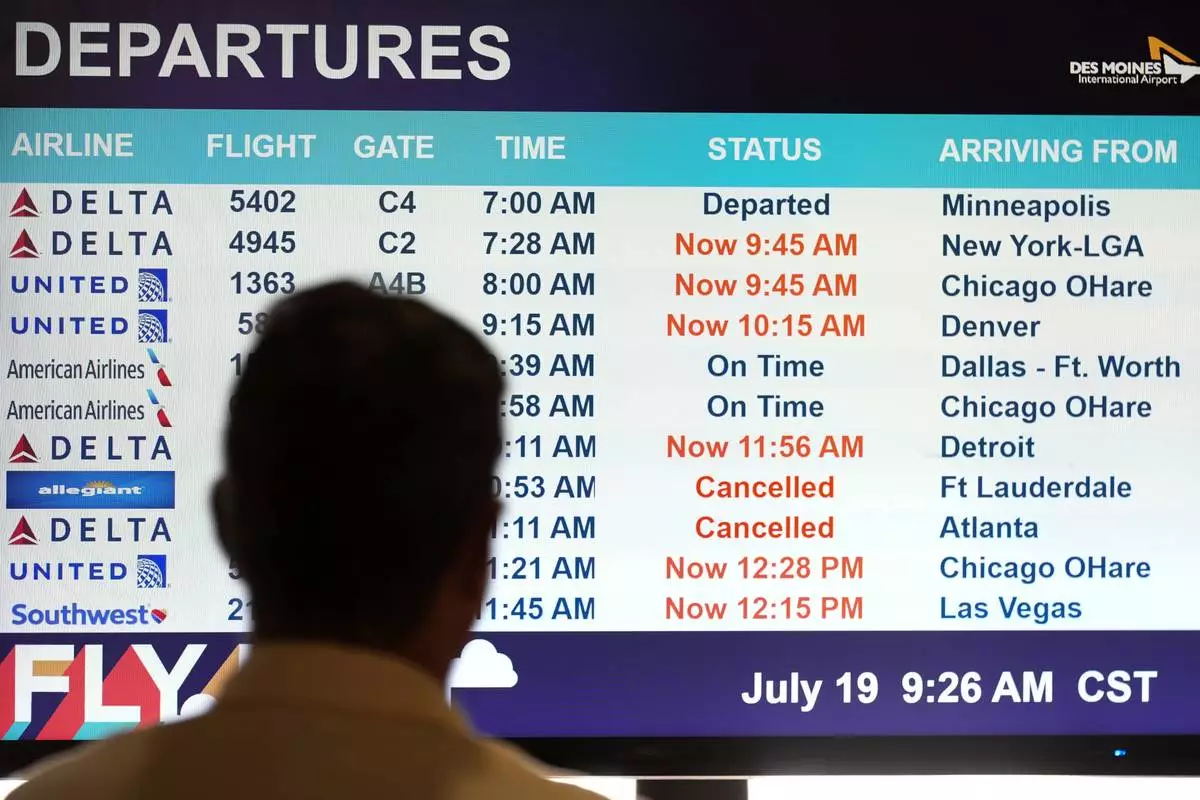
A passenger looks at a departures monitor at the Des Moines International Airport, Friday, July 19, 2024, in Des Moines, Iowa. (AP Photo/Charlie Neibergall)
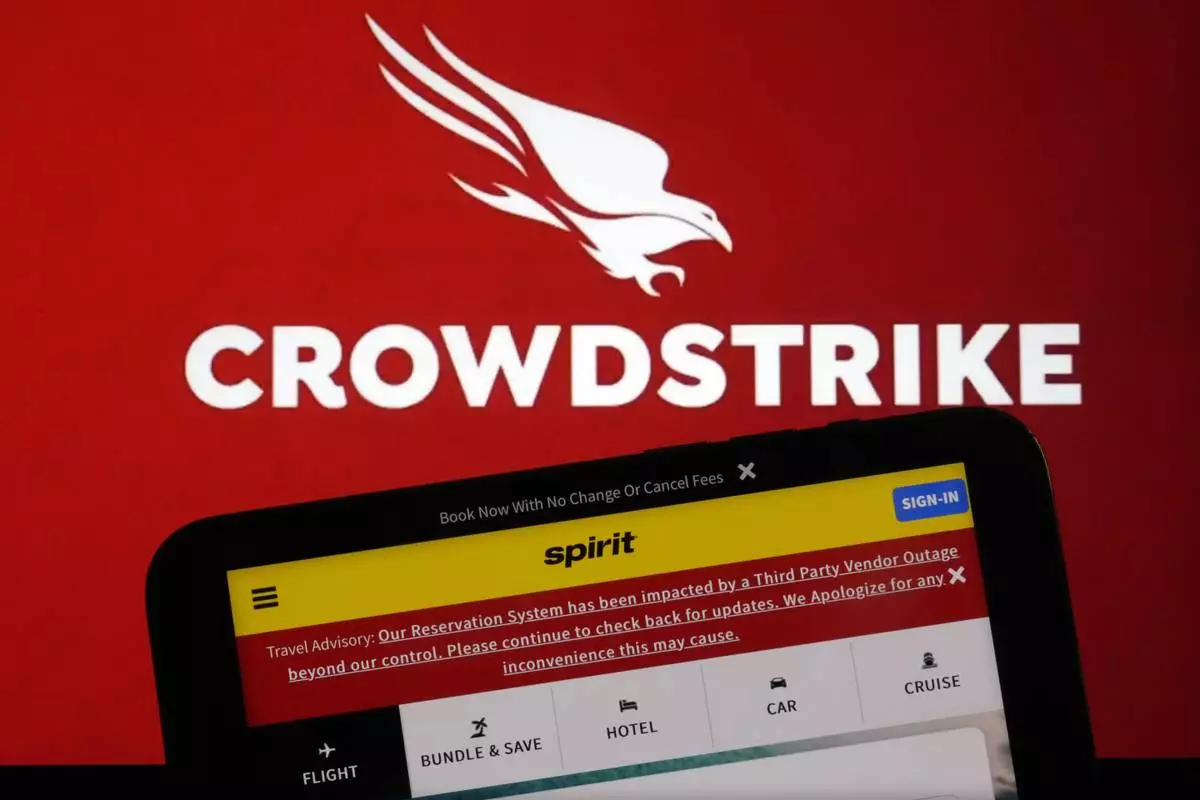
The logo for CrowdStrike and a Spirit Airlines webpage are shown on a computer screen and mobile phone screen, in New York, Friday, July 19, 2024. A global technology outage grounded flights, knocked banks offline and media outlets off air after a faulty software update disrupted companies and services around the world and highlighted their dependence on just a handful of providers. (AP Photo/Richard Drew)
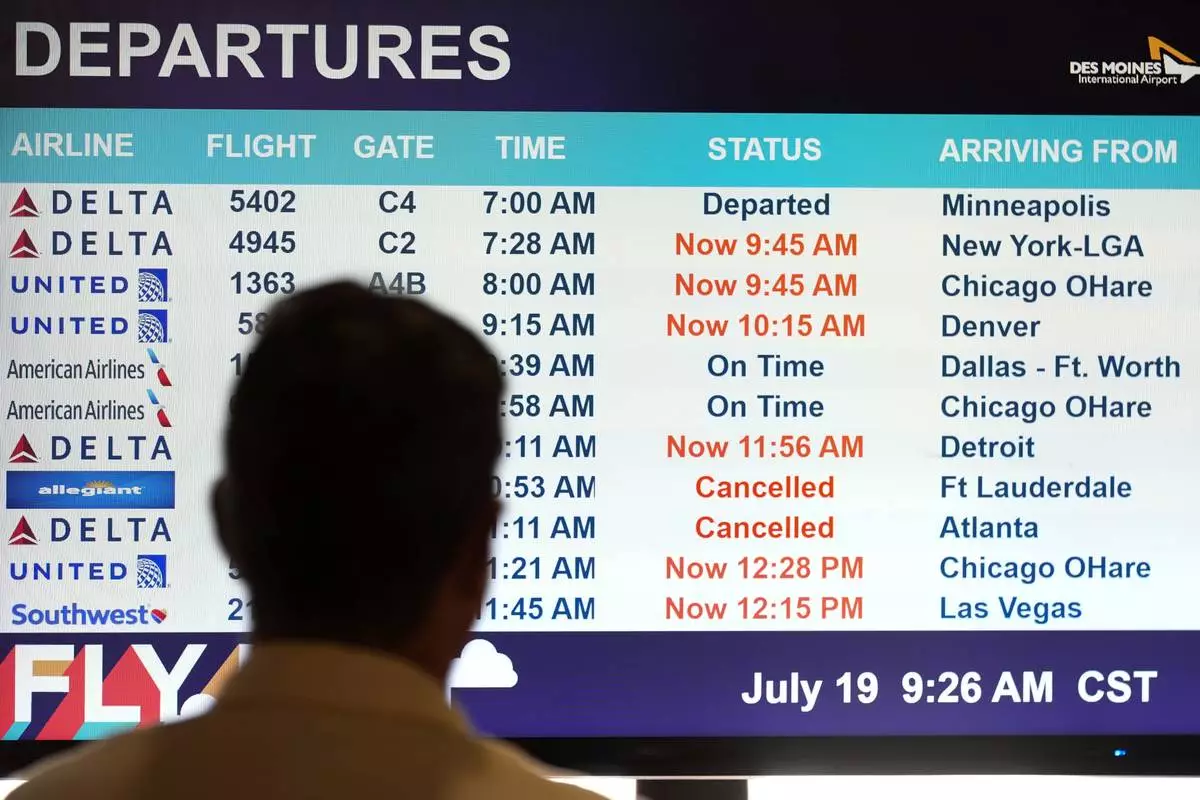
A passenger looks at a departures monitor at the Des Moines International Airport, Friday, July 19, 2024, in Des Moines, Iowa. (AP Photo/Charlie Neibergall)
NEW YORK (AP) — Another rout hit Wall Street Friday, with formerly high-flying technology stocks again taking the brunt, after a highly anticipated update on the U.S. job market came in weak enough to add to worries about the economy.
The S&P 500 dropped 1.7% to close out its worst week since March 2023. Broadcom, Nvidia and other tech companies led the market lower as worries continue that their prices soared too high in the boom around artificial intelligence, and they dragged the Nasdaq composite down by a market-leading 2.6%.
The Dow Jones Industrial Average dropped 410 points, or 1%, after erasing a morning gain of 250 points.
Sharp swings also hit the bond market, where Treasury yields tumbled, recovered and then fell again after the jobs report showed U.S. employers hired fewer workers in August than economists expected. It was billed as the most important jobs report of the year, and it showed a second straight month where hiring came in below forecasts. It also followed recent reports showing weakness in manufacturing and some other areas in the economy.
Such a softening of the job market is actually just what the Federal Reserve and its chair, Jerome Powell, have been trying to get in order to stifle high inflation, “but only to a certain extent and the data is now testing Chair Powell’s stated limits,” said Scott Wren, senior global market strategist at Wells Fargo Investment Institute.
Friday’s data raised questions about how much the Federal Reserve will cut its main interest rate by at its meeting later this month. The Fed is about to turn its focus more toward protecting the job market and preventing a recession after keeping the federal funds rate at a two-decade high for more than a year.
Cuts to interest rates can boost investment prices, but the worry on Wall Street is that the Fed may be moving too late. If a recession does hit, it would undercut corporate profits and erase the benefits from lower rates.
“All is not well with the labor market,” said Brian Jacobsen, chief economist at Annex Wealth Management. “The Fed wanted the labor market to come into better balance, but any balancing act is unstable.”
Still, the jobs report did include some encouraging data points. For one, the unemployment rate improved to 4.2% from 4.3% a month earlier. That was better than economists expected. And even if August’s hiring was weaker than forecast, it was still better than July’s pace.
Christopher Waller, a member of the Fed’s board of governors, said in a speech after the jobs report’s release that “I believe we should be data dependent, but not overreact to any data point, including the latest data.”
“While the labor market has clearly cooled, based on the evidence I see, I do not believe the economy is in a recession or necessarily headed for one soon,” he said.
While Waller said he thinks a “series of reductions” to rates is appropriate given that a slowing job market now looks like the bigger threat for the economy than high inflation, he said the ultimate pace and depth of those cuts is still to be determined.
All the uncertainty sent Treasury yields on a wild ride in the bond market as traders tried to handicap the Fed’s next moves.
The two-year Treasury yield initially fell as low as 3.64% after the release of the jobs report, before quickly climbing back above 3.76%. It then dropped back to 3.66% following Waller’s comments, down from 3.74% late Thursday.
Wells Fargo Investment Institute’s Wren said he was surprised by the size of markets’ swings. While data has clearly shown a slowdown in the economy, he’s still forecasting growth to continue, “and it’s not the end of the world.” He cautioned investors against panicking and selling their investments in knee-jerk reactions.
Despite its dismal week, the S&P 500 remains just 4.6% below its all-time high set in July. It’s also still up 13.4% for 2024 so far, which counts as a good year.
A big reason for Friday’s sharp drops was weakness for some big tech stocks that had been benefiting from the AI boom.
Broadcom tumbled 10.4% despite reporting profit and revenue for the latest quarter that were above analysts’ forecasts, thanks in part to AI. The chip company said it expects to make $14 billion in revenue this quarter, which was slightly below analysts’ expectations of $14.11 billion, according to FactSet.
Other chip companies also fell, including a 4.1% drop for Nvidia. After soaring earlier this year as its revenue surged on the AI frenzy, Nvidia’s stock has been shaky since mid-July as investors question whether they took it too high. That’s even though Nvidia has continued to top analysts’ expectations for growth.
“Earnings growth is going to slow from an incredibly high rate to something slower,” Wren said about Big Tech, “but it’s not going to be terrible.”
On the winning side of Wall Street was U.S. Steel, which rose 4.3% after the CEO of rival Cleveland Cliffs told MSNBC that his company would still be interested in acquiring U.S. Steel if the White House were to block its proposed sale to Japan’s Nippon Steel.
All told, the S&P 500 fell 94.99 points to 5,408.42. The Dow dropped 410.34 to 40,345.41, and the Nasdaq composite lost 436.83 to 16,690.83.
In stock markets abroad, indexes fell across much of Europe and Asia. Trading was halted in Hong Kong because of a typhoon.
AP Business Writers Yuri Kageyama and Matt Ott contributed.

FILE - People pass the New York Stock Exchange, at rear, on Aug. 27, 2024, in New York. (AP Photo/Peter Morgan, File)
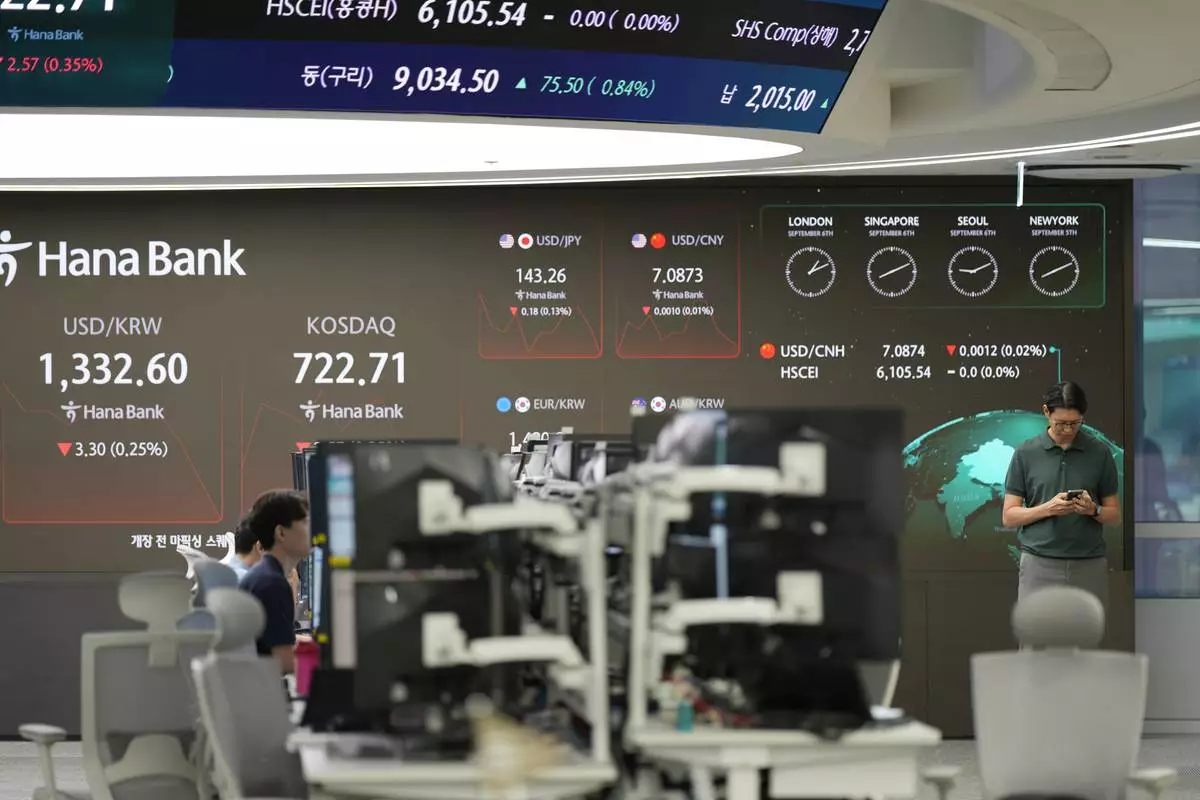
Currency traders watch computer monitors near the screens showing the foreign exchange rates and the Korean Securities Dealers Automated Quotations (KOSDAQ), at a foreign exchange dealing room in Seoul, South Korea, Friday, Sept. 6, 2024. (AP Photo/Lee Jin-man)
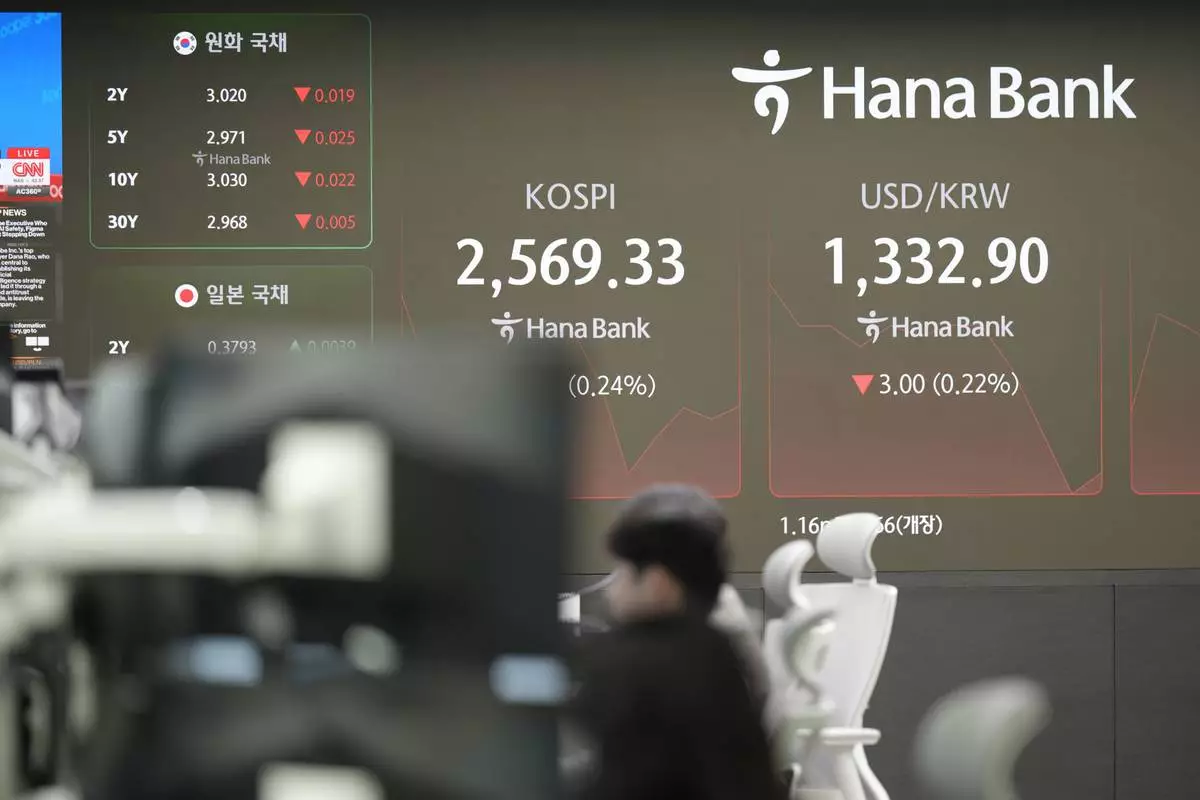
Currency traders watch computer monitors near the screens showing the Korea Composite Stock Price Index (KOSPI), and the foreign exchange rate between U.S. dollar and South Korean won at a foreign exchange dealing room in Seoul, South Korea, Friday, Sept. 6, 2024. (AP Photo/Lee Jin-man)
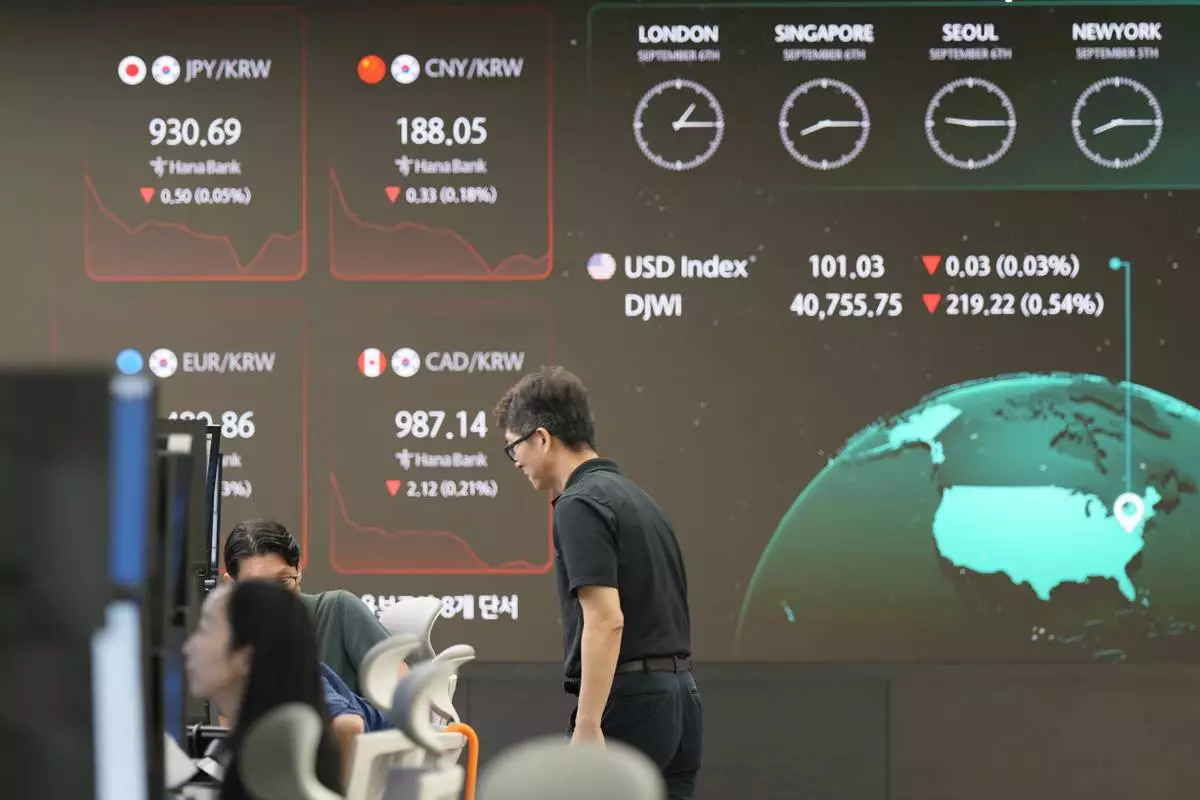
Currency traders talk near the screens showing the foreign exchange rates at a foreign exchange dealing room in Seoul, South Korea, Friday, Sept. 6, 2024. (AP Photo/Lee Jin-man)





